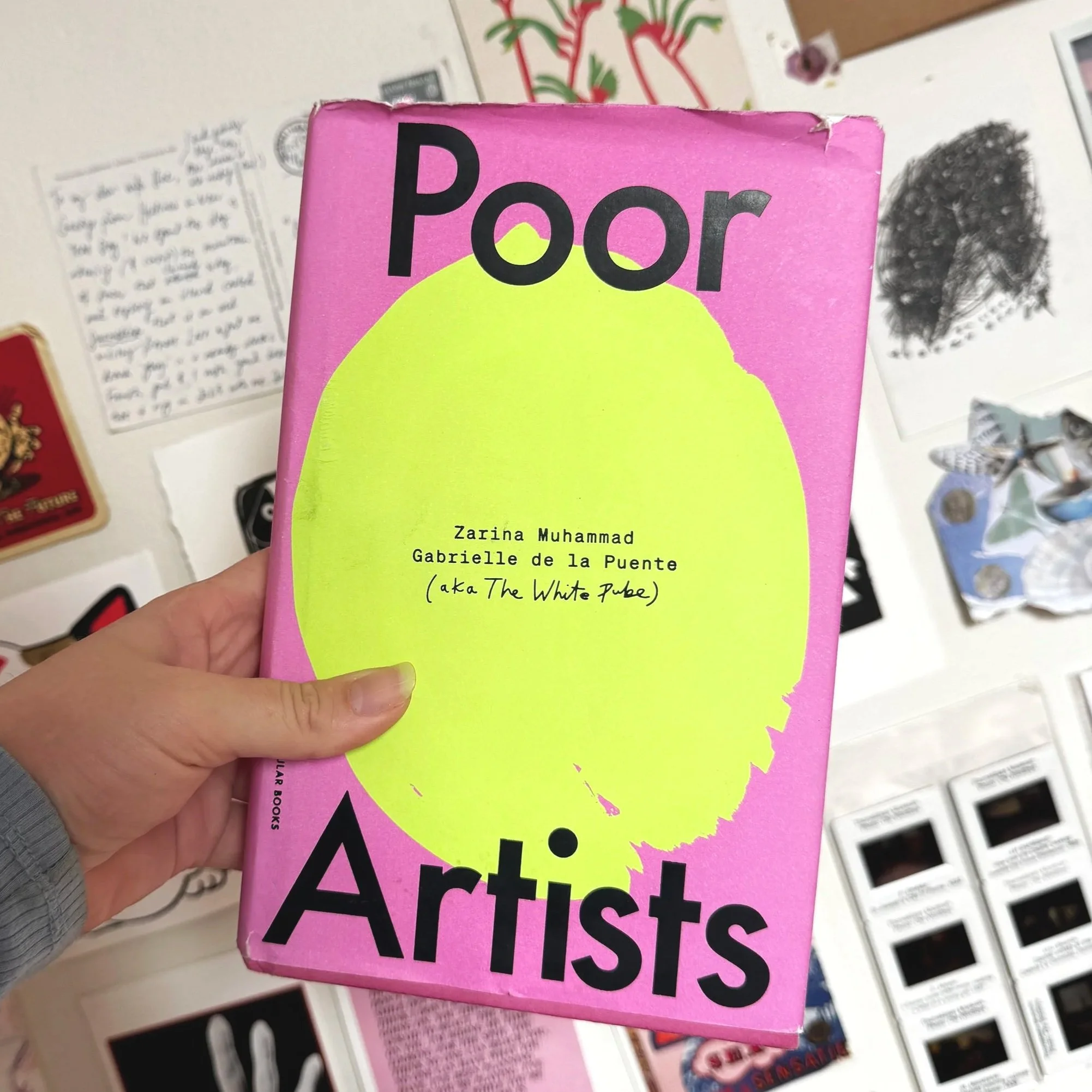Poor Artists; a book review
I was working in a bookstore when Poor Artists hit the shelves and it was one that was mildly contentious in where it should be shelved. Fiction or non-fiction, in the art section or in biography? Poor Artists is like nothing I’ve ever read before in its structure. Co-authors Gabrielle de la Puente and Zarina Muhammad (who I’ll call G&Z from here on out) remind us at the start of the book that this is a piece of art criticism, but I see it more specifically as criticism of the culture that surrounds art instead. Which I guess is exactly what art criticism is. G&Z have been running UK-based arts and culture commentary site The White Pube for ten years and published Poor Artists as a somewhat expansion of that in 2024. For the book G&Z got funding to conduct a series of interviews with people in the art world- artists, curators, gallery directors, technicians, teachers- then moulded those interviews into a narrative.
We see a central character, fictional artist Quest Talukdar, through a surreal series of vignettes on her journey to stay afloat in an industry desperately trying to drag her under. Quest is a muslim working class artist from Liverpool who we see struggling in the classist elitist racist art spaces that are driven by nepotism and wealth. We follow her through dreamlike interactions with several bizarre personifications of the art world who she meets on that journey. Such as; an art school professor who is a sentient pile of unwanted student art, an ageless French man that lives in a disappearing mansion, an Art King that holes up in a colossal castle and makes artists perform for him wearing jester costumes. Okay, admittedly some of the narrative devices are overtly heavy handed, but they make their point. The book has an expositional way of introducing theory, other characters explaining to Quest concepts like death of the artist, or texts such as Uses of the Erotic by Audre Lorde. Yet it feels strangely like G&Z expect the target audience to on one hand have a solid understanding of the art industry and the art history that underpins it, while on the other knowing nothing about any of it and babying the reader through these concepts.
My favourite parts of the book were the chapters that were collections of artworks and performances and installations from real life, which related back to Quest’s narrative, but feel like they were interspersed as reminders of why this whole text has been written. However, there are some chapters that miss as much as there are chapters that hit. I truly didn’t care for Side Quest #1: The Jupiter Residency, or Nineteenth-Century French Painter Gustave Courbet. They feel like unnecessary deviations from both the loose narrative as well as from the political statements the book makes. Yet Cilla Black, Valentine and The Art King had me reading with pen in hand, frantically underlining, and dog earring pages (my book my rules). G&Z use Quest to explore a social and political commentary, which basically boils down to capitalism = bad as capitalism = death of the arts due to exploitation of artists. The book feels like an opportunity for them to say out loud the thoughts and feelings and views that constantly underpin the weekly writing on The White Pube without having to use the vehicle of reviewing something to do so.
As someone who went through art school and never really tried to be a practicing artist afterwards, perhaps Poor Artists resonates with me so much due to my disappointment in the art school machine. The way students are chewed up and spit out, without much (if any) understanding of the functional knowledge needed to pursue making money from our art; ABN’s, tax, networking, pitching, grant writing, blah blah blah. Like Quest says; “art degrees teach critical thinking, and now all I can do is critique the art industry”. Poor Artists is an enjoyable and intriguing read that’s definitely worth it, especially if you're disenfranchised by the current state of the arts and even the wider world. Once you’re done with the book, you can head to The White Pube and read the ten years of back catalogue writing G&Z have published there too lol.
If anyone except the people who marked my final master’s project were to read the 13 page submission outlining the initial ideas and creation stages of Lowbrow, they would find that I mention The White Pube eight times throughout the document. To quote myself; “[Lowbrow] was largely inspired by The White Pube …The writing they publish bridges the gap between formal art critique and casual engagement.” I was introduced to The White Pube during my undergrad Fine Art degree, where we discussed one of their 2018 texts: The Problem with Diaspora Art. Which showed me that despite the informal manner in which the text was written, the ideas were still valued and accepted in my art history class where we usually used much older, stuffier arts writing for our discussions. I even used Poor Artists as a reference in my final ever uni assignment (if I ever say I’m going to do a PhD anyone who has read this has full permission to kick me in the teeth). So shout out Gabrielle and Zarina (I feel like I’m on a first name basis with these two, the parasocial relationship runs deep) for basically being the inspiration for all this!
You can buy Poor Artists at all good bookstores, my personal favourite being Jeffreys Books. Even if it’s not in stock wherever you like to buy books, ask your friendly local bookseller if they can order it in for you! (or you can ask nicely to borrow my copy)

